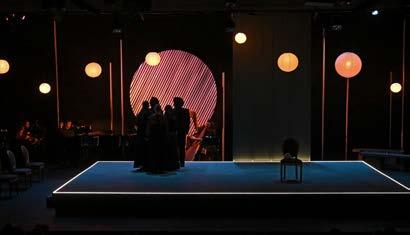
4 minute read
Closing Out 100 Years: A Little Night Music
Interview by: Maya Burdick (' 25), Layout & Design/Social Media Chair
Article by: Ryan Elmore ('26), Editor-in-Chief
Thursday April 10 in Albright Theater Stephen Sondheim and Hugh Wheeler’s A Little Night Music had its first performance before an audience. Directed by Albright Artist-in-Residence and Alumni Jeffrey Lentz, audiences reveled in the production’s four shows and in the talent exhibited by student creatives on and off the stage. The production marked the final show of the Domino Players’ 100th Anniversary Season.
“It’s a piece I longed to do for many years,” Lentz said, “and it requires a certain level of vocal ability, and it seemed like the perfect piece to continue the work we’ve been doing with the vocal performance co-major.”
Lentz, who is a classically trained vocalist and teaches vocal pedagogy, knew it was a piece that demanded a lot of its singers. “It requires a certain level of vocal ability ... the concentrated time just thinking about vocal production and support and then thinking about the incredible score by Sondheim – it all calls on really trained performers.”
Additionally, Lentz had creative challenges to overcome. Set in turn of the century Sweden, work needed to be done to transform the Albright Theater into the space Lentz had envisioned. What resulted was a set that was able to convey the serious emotional stakes of the piece while leaning into a presentational design. Complete with steel beams filling in as trees, hanging lanterns as stars and a giant elevated platform lined with LED lights, the stage offered something never seen before by Albright audiences.
This construction has allowed the show to tell its story in unique ways. Lentz said, “We were able to organize the space in such a way that was a wonderful touchstone for the performers because once [they understood] they were being supported [by the design] they could feel grounded.”
Another challenge was making the characters – largely Swedish aristocracy from a hundred years ago – relatable and arresting for Albright audiences. “When you strip it bare and when you have young people performing [the show] who are having to explore the faults and foibles of human beings, it reveals a common experience.”
With the show’s four performances, Albright students as well as members of the Greater Reading community were seriously impressed, having connected with the show in unexpected ways. Some audience members cited the show’s idiosyncratic design and stellar performances from cast members such as Mara Nagle who played Desiree Armfeldt and Isabella Tewfik who played Anne Egerman.
Luke Perkins, also hailed for their performance as Fredrik Egerman, enjoyed exploring each character’s complexity. “All these characters are real – they're human,” they said. “They all have flaws, none of them are these perfect people you aspire to be like and that’s true to the real world.”
Looking back on the show a week after its full run, Lentz is still riding the production’s high. "More than anything, I was looking forward to introducing our theatre/vocal performance students and our audiences to the musical splendor of this amazing work ... our company of singing actors and our amazing crew far exceeded even their own expectations.”
The costumes, elegant formal wear complete with tailored dresses and tuxedos, were designed by Liz Polley. The stylized lighting design was created by Jen Rock in her final production at Albright College. The set was designed by Mike Rhoads and constructed by Adam Kissinger. The show saw eight musicians making up the show’s orchestra led by music director Jimmy Damore. Amara Fabry acted as the production stage manager and Murphy McCabe acted as assistant director.
“This was definitely one of the most, if not the most, delightful rehearsal processes I've ever experienced,” Lentz said. “It was that magic amalgam of a brilliant work and a brilliant team! I'm so grateful. “






